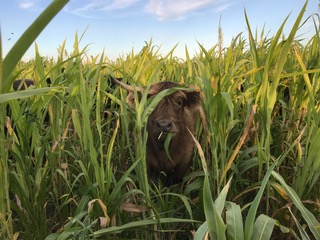 There is no denying it. Grass Fed Beef, no matter where you see it is always priced higher than grain fed beef. that is because they are produced so, so much differently. The difference is somewhat similar to products being factory made vs. hand made. You would expect to pay more for hand crafted, well…anything. Feedlots that house grain fed animals are similar to factories in many ways. They are mass producing their product in the fastest, and most cost effective way possible. It’s still a lot of work, but everything is streamlined. Feed and grain is bought, stored and then fed to the cattle in their containment pens, every day, etc. This also doesn’t take much real estate to feed a very large amount of animals.
There is no denying it. Grass Fed Beef, no matter where you see it is always priced higher than grain fed beef. that is because they are produced so, so much differently. The difference is somewhat similar to products being factory made vs. hand made. You would expect to pay more for hand crafted, well…anything. Feedlots that house grain fed animals are similar to factories in many ways. They are mass producing their product in the fastest, and most cost effective way possible. It’s still a lot of work, but everything is streamlined. Feed and grain is bought, stored and then fed to the cattle in their containment pens, every day, etc. This also doesn’t take much real estate to feed a very large amount of animals.
The animals are fed corn and silage which are very cost effective. They are relatively cheap feed sources and the cattle fatten very quickly while eating them. They are fed there for about 4-8 months and then slaughtered around 18 months of age.
In contrast, Grass Fed Beef is a much longer, and customizable process, taking 28-30 months and sometimes even longer, depending on rainfall and animal genetics. The Cattle are moved frequently on the range. They require many acres of native grass and drilled forages to support their growth, weight gain and marbling. So, not only does this process take up more real estate and time, it also takes a patient, and customizable approach. Getting the right forages, with the right nutrition at the right state of growth is key. Feedlots also customize their rations, it’s just done with scales and a feed truck. Grass Fed producers rely on God for our finishing process, each step of the way. For instance, in drilling the forages to finish our cattle, we rely on God’s rain, sunshine, and heat. And yet if we have too much heat in summer months, the animals will not gain as well because they spend most of their time drinking from water tanks in the shade. Similarly, drought and other weather events, can be very detrimental to the gain of the cattle.
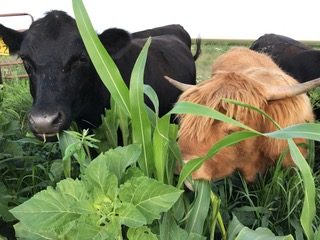 Also, Grass Fed Beef has no antibiotics, steroids, or hormones. These three things are also, very cost effective for weight gain. Therefore, the Grass Fed animals are usually smaller than feedlot fattened animals.
Also, Grass Fed Beef has no antibiotics, steroids, or hormones. These three things are also, very cost effective for weight gain. Therefore, the Grass Fed animals are usually smaller than feedlot fattened animals.
So the bottom line is this. Feedlots are able to finish their animals quickly and cost effectively and have very large animals as a finished product. While Grass Finishing is slow, dependent on God’s weather, and has relatively smaller animals as a finished product. This sums up the very vast difference in price.
This is where our beef truly stands out in the Grass Finished industry. When we switched from raising grain fed beef to Grass Finished beef, we weren’t willing to skimp on marbling. We researched Grass Finishing, and met with the leading consultants in the country on this very topic and then we went to work. We are very blessed to have cattle with very good genetics, that produce marbling in the meat with ease. Our family prefers, USDA Choice, Grass Finished beef, and are excited to offer this to you as well!
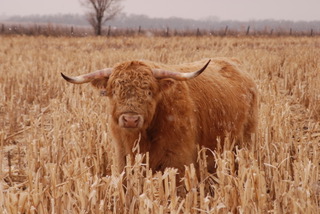 Our cattle are allowed to graze fields after they are harvested in winter months for about 60 days, when nothing else is growing. When harvesting with the combine there are occasional, tiny amounts of grain that can fall on the ground. This is the cattle’s only encounter with grain in their lives. This is very minimal, because we strive to never leave grain behind in the field. That is literally throwing money on the ground, which is not our goal!
Our cattle are allowed to graze fields after they are harvested in winter months for about 60 days, when nothing else is growing. When harvesting with the combine there are occasional, tiny amounts of grain that can fall on the ground. This is the cattle’s only encounter with grain in their lives. This is very minimal, because we strive to never leave grain behind in the field. That is literally throwing money on the ground, which is not our goal!
They are fed alfalfa as a treat to aid in taming the animals and for when moving across roads, and to new pastures. This is to encourage the cattle to follow our pickup truck instead of roam across the open range to the neighbor’s fields!
Frozen meat has gotten a bad reputation through many marketing plans. This is in part due to people thinking about meat that heads to the freezer, instead of to the trash once it is past it’s shelf life in the cooler.
Our beef is frozen right after butchering, locking in nutrients, taste and tenderness. It is processed in a USDA butcher shop that packages the meat fresh and is put straight into the freezer, where it has a shelf life of over 2 years due to it’s secure vacuum sealed package!
Freezing the meat also allow us to finish the animals during peak season of the the forages, and/or when the animals are at their prime potential, with the most marbling in their meat. That way we get the highest quality product we can produce and you get to consume the meat when you want!
A day on Walnut Range Farms includes checking on all the animals. Watering, checking salt and mineral tubs, building fence, moving cattle to new pasture and fields, and Boxing and shipping orders for you and your family!
The seasons change our daily outlook of work. During Spring we are calving, drilling cover crops for spring grazing, moving cows to spring and summer pasture, and checking and building fence. Summer is much the same, but includes making sure the animals have plenty of shade and water to handle the stress of the heat we experience in Nebraska summer months. Fall is very busy with rounding up cattle from summer pasture, weaning calves, bringing home hay bales for the coming winter, and winterizing tanks, hoses, and wells. Winter keeps us very busy, chopping ice on water sources for the cattle, pitching hay for feed supplements, and we are always on the ready for a nasty Nebraska blizzard. When that happens, we move the cattle ahead of the storm to the best windbreak and/or shelter that is closest to them. We get them fed and watered, and then lay out straw for them to bed down on to help them endure the storm. And then we pray for God to watch over them!
No matter what the season, we are always continuing to research ways to better our range, beef, and environment. We finish each day the same as you…we head home to feast on our delicious Grass Finished Beef!
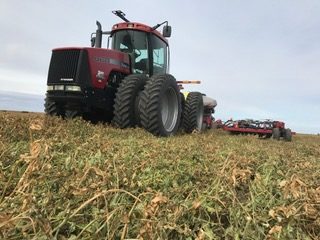 ‘Cover crops’ is a term used to describe many, many different species of forages that we plant into the soil, and then are grazed by the cattle and hogs. Just to name a few species… Kale, Collards, Barley grass, alfalfa, clover, chickling vetch, forage peas, okra, and many many other grasses. We talk and consult with our local Cover Crop Company that customizes and blends our forage species mix. We then pick up the mix with a truck, put it in our drill (our ‘drill’ is the machine that hooks onto our tractor and plants the seeds in the ground), and head out to the fields. We plant the seeds and then wait for God’s amazing system to kick in, of growing a seed into a plant, converting to a food source, eaten and digested, turning into high quality meat, all while the animals are spreading their ‘fertilizer’ back into the soil! So, these ‘cover crops’ help us turn our cattle into high quality, healthy, well marbled and of course delicious Grass finished beef!
‘Cover crops’ is a term used to describe many, many different species of forages that we plant into the soil, and then are grazed by the cattle and hogs. Just to name a few species… Kale, Collards, Barley grass, alfalfa, clover, chickling vetch, forage peas, okra, and many many other grasses. We talk and consult with our local Cover Crop Company that customizes and blends our forage species mix. We then pick up the mix with a truck, put it in our drill (our ‘drill’ is the machine that hooks onto our tractor and plants the seeds in the ground), and head out to the fields. We plant the seeds and then wait for God’s amazing system to kick in, of growing a seed into a plant, converting to a food source, eaten and digested, turning into high quality meat, all while the animals are spreading their ‘fertilizer’ back into the soil! So, these ‘cover crops’ help us turn our cattle into high quality, healthy, well marbled and of course delicious Grass finished beef!
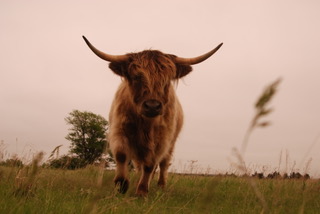 We are very passionate about our Scottish Highland and Angus cattle.
We are very passionate about our Scottish Highland and Angus cattle. 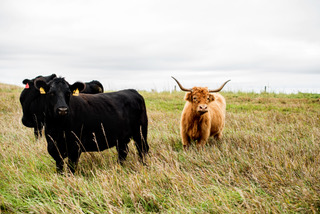 They are both extremely well suited to grass finishing.
They are both extremely well suited to grass finishing.
The Scottish Highland are excellent grass conversion animals, and have a rare characteristic of being extremely tender, due to their very small muscle fibers. . The Angus have amazing marbling and grow quicker than the Scottish Highlands. Both breeds are very docile, flavorful, tender, juicy and well marbled. Therefore, we are building our herd to combine these breeds. We are using Scottish Highland bulls with Angus Cows and getting the best of both worlds, so to speak.
If you have a preference on which breed you order, please contact us, and we will ship you the meat you want, as long as it is in stock!
Yes! We take very good care of the animals that God has given us the responsibility to care for. They all live their lives, happy and content, free to roam on our range!
The cattle are moved often on high quality grass and forages. We also supply plenty of water and shade during the summer months, and we do our best to provide protection in the winter from blizzards, and extreme cold.
After living a happy life on the range, the animals are loaded as stress free as possible onto trailers, hauled by ourselves a short 30 mile drive to the butcher and unloaded in a USDA inspected, stress-free facility.
Why does the Fat on my beef sometimes look yellow, and sometimes look white when I receive an order?
his is due to when it is butchered. When our beef is butchered in the summer and fall months, the fat on the beef tends to have a more white appearance. We call this our ‘peak’ butchering season. The natural sugars are higher in the grasses at this time and attributes to the white fat. The yellow fat is more prominent in the winter and early spring months, while plant sugars are still deep in the roots of all the grasses. They both have beautiful marbling and flavor!
An excellent question that stumps some of the best Nebraska Cattle Producers. The environment allows us to use breeds that are not influenced by the Brahma breed. Generally, southern Brahma cross cattle are utilized in regions of high heat and insect pressure throughout the year, but this cross of cattle historically will not marble the meat very well, has more connective tissue and is not as desirable for high end culinary applications. Most of the grass fed beef imported into the U.S. is Brahma influenced and then sliced very thinly to mask the toughness. We love that our environment is suitable for the Scottish highland and Angus breeds, than produce well marbled, tender Grass Fed Beef.
Nebraska is the farthest south area of the Northern cattle region. Our growing season is longer than the rest of the Northern region, allowing our beef animals to forage on grass and cover crop species for a greater period of time. A combination of environment, cattle breeds, and high quality genetics, equates to outstanding beef.





